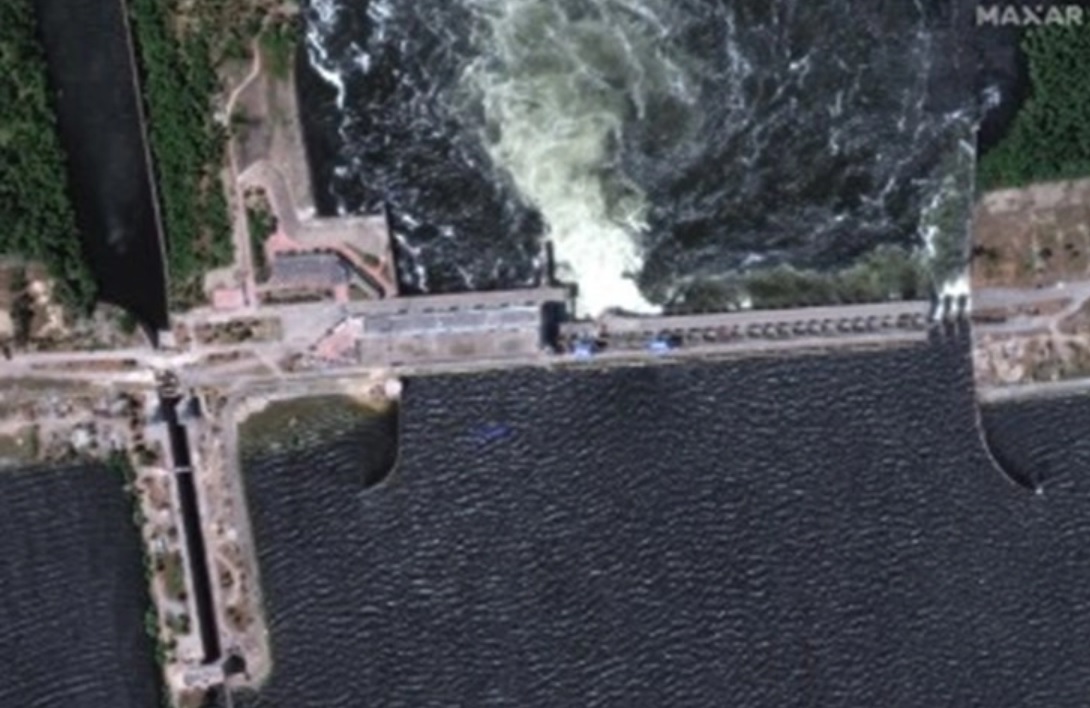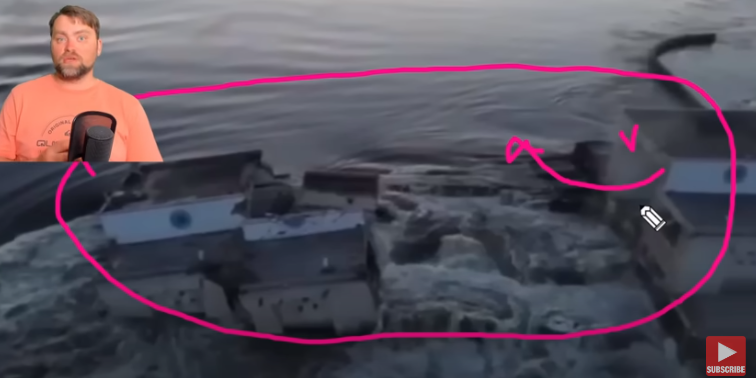Photo: Screenshot
– In conditions when both Ukraine and Russia are accusing each other for demolishing the dam, and when investigations are being announced.
– The fact is that Ukraine did not have access to the dam and that it was under the control of Russian troops. Moreover, experts point out that the dam cannot be demolished by bombing because it has a strong structure and most probably it was demolished by an explosion from the inside. Evidence of that is the smoke seen on the video recordings that appear close to the Russian Guard.
– The United Nations and the USA do not want to point their finger at anyone as the direct party to blame without concrete information, writes Truthmeter.mk.
Under the content-sharing agreement between Truthmeter.mk and Meta.mk, we republish the text below:
Namely, the investigation of the events on the dam Nova Kakhovka is still ongoing because the Ukrainian and the Russian side are both accusing each other of the largest environmental disaster up to date – as assessed by many. The Nova Kakhovka Dam was destroyed on 6 June. In the morning, Ukrainian Forces Command South announced that the Russian forces demolished the dam.
Ukrainian President, Volodymyr Zelenskyy, twittered a video of the destroyed dam calling the Russian forces in Ukraine “terrorists”.
Russian terrorists. The destruction of the Kakhovka hydroelectric power plant dam only confirms for the whole world that they must be expelled from every corner of Ukrainian land. Not a single meter should be left to them, because they use every meter for terror, Zelenskyy wrote.
Following Kyiv’s allegations that Russian forces destroyed the Kakhovka Dam on the Dnipro River, official Kremlin responded by accusing Ukraine of deliberate sabotage in order to distract attention from the unsuccessful counter-offensive against the Russian forces.
What is happening with the dam?
An intended explosion in Kakhovka Dam, most probably, caused its collapse, deem the engineering and the ammunition experts, according to whom structural malfunction or an attack from the outside is possible but less credible, New York Times reported.
Ihor Syrota, Head of Ukrhydroenergo, the state hydroelectric power plant, stated:
A missile attack would not cause such destruction, because this power plant was constructed to withstand an atomic bomb. Clearly: there was an explosion within the station and the station broke down in half.
As the newspaper reported, experts cautioned that the available evidence was very limited, but they said that an internal explosion was the likeliest explanation for the destruction of the dam, a massive structure of steel-reinforced concrete that was completed in 1956. And local residents reported on social media that they heard a huge explosion around the time the dam was breached, at 2:50 a.m.
A blast in an enclosed space, with all of its energy applied against the structure around it, would do the most damage. Even then, the experts said, it would require hundreds of pounds of explosives, at least, to breach the dam. An external detonation of a bomb or a missile would exert only a fraction of its force against the dam and would require much more explosives to achieve a similar effect.
You’re going to be limited in how much a warhead can carry. Even a direct hit may not take out the dam. This takes a significant amount of energy. You think about the forces on the structure in operation – they are immense. You have the water force, which is massive. This is not like holding on by a thread; these things are tough”, says Nick Glumac, professor, and explosives expert at the University of Illinois at Urbana-Champaign, reported New York Times.
According to the published photographs and videos, the Kakhovka Dam was first breached in the middle, right next to the power plant on the border with the Russian Guard.
 Photo: Screenshot of satellite photographs shared on social networks
Photo: Screenshot of satellite photographs shared on social networks
Mutual allegations
According to Ukraine’s Southern Operational Command, the dam was destroyed by Russian forces. Later on, National Security and Defence Council Secretary, Oleksii Danilov, said that it was blown up by Russia’s 205th Motorized Rifle Brigade.
The plenipotentiary installed by Russia in Nova Kakhovka first denied that the dam was destroyed, and later claimed that it was targeted by Ukrainian shelling.
Danilov rejected Russia’s claims by saying that Kremlin developed sabotage plans last autumn.
According to the Ukrainian authorities, the dam was shelled last October when the Ukrainian forces were advancing in the Kherson Region.
Mutual allegations and warnings related to the destruction of the dam were present in 2021. Then, Russia and Ukraine mutually accused each other for planning to blow-up the hydroelectric dam Kakhovka.
Sergei Surovikin, Commander of Russian forces in Ukraine, said at the time that he had information that Ukrainian forces were preparing a massive strike on the dam and had already used US-supplied HIMARS missiles of a major strike, he said, could be a disaster.
We have information on the possibility of the Kyiv regime using prohibited methods of war in the area of the city of Kherson, on the preparation by Kyiv of a massive missile strike on the Kakhovka hydro-electric dam, said Surovikin, as reported by Reuters.
Ukrainian officials said the allegation was a sign that Moscow planned to attack the dam and blame Kyiv.
Ukrainian President, Volodymyr Zelenskyy said that Russia had mined the dam and was preparing to blow it, a step he compared to the use of weapons of mass destruction.
I informed the Europeans today, during the meeting of the European Council, about the next terrorist attack, which Russia is preparing for at the Kakhovka hydroelectric powerplant. Destroying the dam would mean a large-scale disaster, he said.
Is it possible for Ukraine to blow up its own dam?
In a video on YouTube, blogger Denys Davydov gives a detailed analysis of what had happened, the ramifications of the destruction of the dam as well as who could be blamed for such a disaster.
The published recordings show that there was smoke, which means that the explosion was internal, says Davydov (5:27 in the video).
 Photo: Screenshot from YouTube video of blogger Denys Davydov
Photo: Screenshot from YouTube video of blogger Denys Davydov
The video provides the explanation that a road goes through the dam. The Russians had demolished part of the road so that the Ukrainians could not pass. Therefore, the Ukrainians could not physically come to the part where the explosion of the dam had occurred, because the road was “totally kaputt”, says the video.
Sergiy Kyslytsya, the Ukraine Envoy to the UN, said it was typical of Russia to blame the victim for its own crimes, pointing out Russia has been in control of the dam for more than a year and it was physically impossible to blow it up by shelling. He said the dam was mined by the Russian occupiers and they blew it up. He accused Russia of “floundering again in the mud of lies”.
By resorting to scorched earth tactics, or in this case, to flooded earth tactics, the Russian occupiers have effectively recognised the captured territory does not belong to them, and they are not able to hold these lands, said Kyslytsya for the Guardian.
Neither the French, US, or British representatives at the UN directly said there was evidence of Russian responsibility, but called for an investigation and insisted their support for Ukraine was unwavering.
The Deputy US Ambassador to the UN, Robert Wood, said:
We’re not certain at all, we hope to have more information the coming days. But, I mean, come on… why would Ukraine do this to its own territory and people, flood its land, and force tens of thousands of people to leave their homes – it doesn’t make sense.
Martin Griffiths, the UN humanitarian envoy, did not accuse Russia of responsibility for the humanitarian disaster, saying investigations would be held, but he asserted that the incident would not have occurred if it were not for Russia’s invasion.
The UN “has no access to independent information on the circumstances that led to the destruction of the hydroelectric power plants”, he said, but added that the destruction of the dam was one of the most significant pieces of damage to Ukrainian infrastructure since the war started, reported Guardian.
The State Department informed that the USA does not have enough information about the reasons for the Nova Kakhovka dam disaster.
We will provide full information when that will be possible, said Vedant Patel, Principal Deputy Spokesperson at the US Department of State.
He refused to comment on the articles of some American media that Washington possessed intelligence information pinpointing the involvement of Moscow in sabotaging the dam.
We continue to support our Ukrainian partners in their efforts to protect their territorial integrity and sovereignty and the protection of its people, said Patel, adding that Washington was working directly with Kyiv in delivering aid to those who had suffered from the destruction of the dam.
In a situation when Russia and Ukraine are accusing each other for the destruction of the dam, and when investigations are being announced, one cannot say with certainty that Ukraine shelled the dam as it is done in the post we are fact-checking.
It is a fact that Ukraine did not have access to the dam and that the dam was controlled by Russian troops. Moreover, experts are pointing out that the dam cannot be destroyed by shelling, because its has a strong structure and most probably it was destroyed by an explosion within, proved by the smoke appearing on the video and coming from a place close to the Russian Guard.
The United Nations and the USA do not want to directly blame anyone without specific information.




